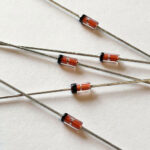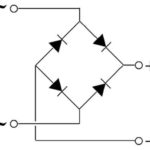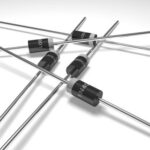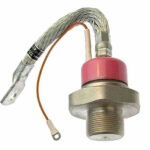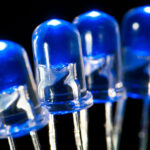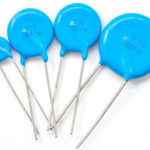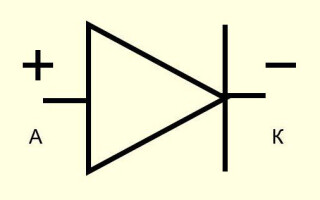Semiconductor diode is widely used in electrical engineering and electronics. With a low cost and good power to size ratio, it quickly displaced vacuum devices of similar purpose.
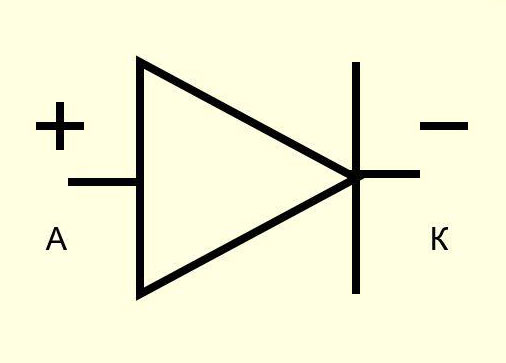
Contents
Construction and Operation Principle of a Semiconductor Diode
A semiconductor diode consists of two regions (layers) made of a semiconductor (silicon, germanium, etc.). One region has an excess of free electrons (n-semiconductor), the other has a shortage (p-semiconductor) - this is achieved by doping the base material. Between them there is a small size zone in which the excess of free electrons from the n-side "closes" the holes from the p-side (recombination occurs due to diffusion), and there are no free charge carriers in this area. When a direct voltage is applied, the recombination region is small, its resistance is small, and the diode conducts current in this direction. When a reverse voltage is applied, the carrierless area will increase, and the diode resistance will increase. No current will flow in this direction.
Types, Classification, and Graphics in Electrical Circuits
In general, a diode in a circuit is designated with a stylized arrow indicating the direction of the current. The conventionally graphic depiction (CSD) of a device contains two leads - anode and cathodewhich in a direct connection are connected to the plus side of the circuit and to the minus side, respectively.

There are many varieties of this two-pole semiconductor device, which, depending on their purpose, may have a slightly different CSD.
Stabilitrons (Zener Diodes)

A stabilitron is a semiconductor deviceIt operates with a reverse voltage in the avalanche breakdown region. In this region, the Zener diode voltage is stable over a wide range of current through the device. This property is used to stabilize the voltage across the load.
Stabilistors
Stabilitrons do a good job of stabilizing voltages from 2 V and above. To get a constant voltage below this limit, stabilitrons are used. By doping the material from which these devices are made (silicon, selenium) the highest verticality of the straight line characteristic is achieved. This is the mode in which the stabilizers operate, producing a reference voltage within 0.5...2 V on the direct branch of the volt-ampere characteristic at the forward voltage.
Schottky Diodes

The Schottky diode is based on a semiconductor-metal circuit and does not have a common junction. This results in two important properties:
- Reduced forward voltage drop (about 0.2 V);
- higher operating frequencies due to lower intrinsic capacitance.
The disadvantages include increased reverse currents and reduced tolerance to reverse voltage levels.
Varicaps

Each diode has an electrical capacitance. Two volumetric charges (p and n semiconductor regions) serve as the covers of the capacitor, and the locking layer is the dielectric. When a reverse voltage is applied, this layer expands and the capacitance decreases. This property is inherent to all diodes, but in varicaps the capacitance is normalized and known at given voltage limits. This allows such devices to be used as capacitors of variable capacity and used for tuning or fine-tuning of circuits by supplying different levels of reverse voltage.
Tunnel diodes

These devices have a deflection in the forward section of the characteristic, in which an increase in voltage causes a decrease in current. In this region, the differential resistance is negative. This property allows tunnel diodes to be used as amplifiers for weak signals and oscillators at frequencies above 30 GHz.
Dynistors

A dynistor, which is a diode thyristor, has a p-n-p-n structure and S-shaped waveform, and does not conduct current until the applied voltage reaches a threshold level. After that, it opens and behaves like a normal diode until the current falls below the hold level. Dinistors are used in power electronics as switches.
Photodiodes

A photodiode is made in a housing with visible light access to the crystal. When the p-n junction is irradiated, an EMF is generated in it. This makes it possible to use the photodiode as a current source (as part of solar cells) or as a light sensor.
LEDs

The main property of a photodiode is that it can emit light when a current flows through a p-n junction. This glow is not related to the intensity of heating, as in the incandescent lamp, so the device is economical. Sometimes the direct glow of the transition is used, but more often it is used as a phosphor ignition initiator. This made it possible to obtain previously unattainable LED colors, such as blue and white.
Gunn Diodes
Although a Gann diode has the usual conventional graphic designation, it is not a diode in the full sense. This is because it has no p-n junction. This device consists of a gallium arsenide plate on a metal substrate.
Without going into the subtleties of the processes: when applying an electric field of a certain value in the device, there are electric oscillations, the period of which depends on the size of the semiconductor plate (but within certain limits the frequency can be corrected by external elements).
Gann diodes are used as oscillators at frequencies of 1 GHz and higher. The advantage of the device is the high frequency stability, and the disadvantage is the small amplitude of the electric oscillations.
Magnetodiodes
Conventional diodes are weakly affected by external magnetic fields. Magnetodiodes have a special design that increases the sensitivity to this influence. They are made using p-i-n technology with an extended base. Under the influence of a magnetic field, the device resistance in the forward direction increases, and this can be used to create contactless switching elements, magnetic field transducers, etc.
Laser diodes
The principle of operation of a laser diode is based on the property of the electron-hole pair to emit monochromatic and coherent visible radiation under certain conditions during recombination. Ways to create these conditions are different; the user only needs to know the wavelength emitted by the diode and its power.
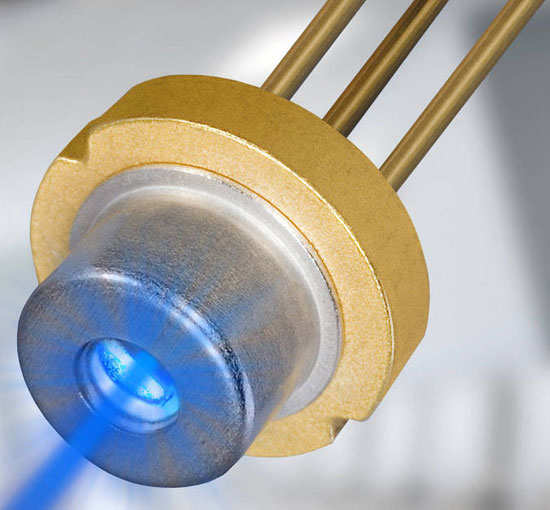
Avalanche spanning diodes.
These devices are used in microwave applications. Under certain conditions in the avalanche breakdown mode, a section with negative differential resistance appears on the diode characteristic. This property of LPDs allows them to be used as generators, working at wavelengths up to millimeter range. There it is possible to get the power of not less than 1 W. At lower frequencies, up to several kilowatts are removed from such diodes.
PIN diodes
These diodes are made using p-i-n technology. Between the doped layers of semiconductors is a layer of un-doped material. For this reason, the rectifier properties of the diode are worsened (recombination is reduced at reverse voltage due to the absence of direct contact between p- and n-zones). But due to the separation of bulk charge regions, the parasitic capacitance becomes very small, signal leakage at high frequencies is practically eliminated in the closed state, and pin diodes can be used at HF and UHF as switching elements.
Main characteristics and parameters of diodes
The main characteristics of semiconductor diodes (except for highly specialized ones) are:
- The maximum allowable reverse voltage (DC and pulse);
- limit operating frequency;
- forward voltage drop;
- operating temperature range.
The other important characteristics are better to consider on the example of diode's CVC - so it is more clear.
Volt-ampere characteristic of a semiconductor diode
The volt-ampere characteristic of a semiconductor diode consists of a forward branch and a reverse branch. They are located in quadrants I and III, because the direction of current and voltage through the diode always coincide. From the volt-ampere characteristic it is possible to determine some parameters and also to see visually what the characteristics of the device influence.
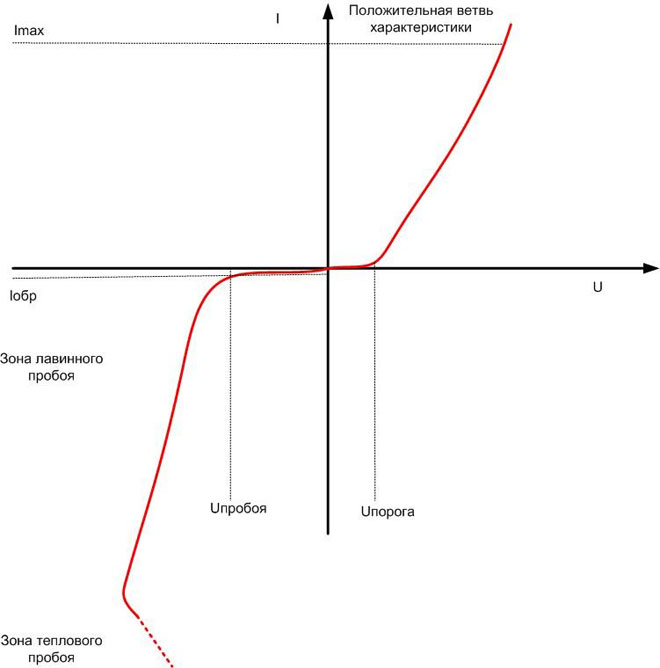
Conductivity Threshold Voltage
If a direct voltage is applied to the diode and starts to increase it, at first nothing will happen - the current will not increase. But at a certain value the diode will open and the current will increase according to the voltage. This voltage is called the conductivity threshold voltage and is marked on the VAC as U-threshold. It depends on the material from which the diode is made. For the most common semiconductors this parameter is:
- silicon - 0.6-0.8 V;
- Germanium - 0.2-0.3 V;
- gallium arsenide - 1.5 V.
The property of germanium semiconductors to open at low voltage is used in low-voltage circuits and other situations.
Maximum current through a diode when switched on directly
After a diode has opened, its current increases with the increase in forward voltage. For an ideal diode, this graph goes to infinity. In practice, this parameter is limited by the semiconductor's ability to dissipate heat. When a certain limit is reached, the diode will overheat and fail. To avoid this, manufacturers specify the highest allowable current (Imax on the BAC). It can be roughly determined by the size of the diode and its housing. In descending order:
- the highest current is held by devices in a metal shell;
- Plastic enclosures are designed for average power;
- diodes in glass cases are used in low-current circuits.
Metal devices can be mounted on radiators - this will increase the power dissipation.
Reverse Leakage Current
If reverse voltage is applied to a diode, a low-sensitivity ammeter will show nothing. In fact, only a perfect diode does not leak any current. A real device will have current, but it is very small, and is called reverse leakage current (on the VAC, Iobr). It is tens of microamperes or tenths of milliamperes and is much smaller than the forward current. You can find it in a reference book.
Breakdown Voltage
At a certain value of reverse voltage, there is a sharp increase in current called breakdown. It has a tunneling or avalanche character and is reversible. This mode is used to stabilize the voltage (avalanche mode) or to generate pulses (tunnel mode). As the voltage increases further the breakdown becomes thermal. This mode is irreversible and the diode fails.
Parasitic capacitance of pn junction
It has already been mentioned that the p-n junction has electrical capacitance. And if in varicaps this property is useful and used, in ordinary diodes it can be harmful. Although the capacitance is in the order of units or tens of pF and is unnoticeable at DC or low frequencies, its effect increases as frequency increases. A few picofarads at RF will create a low enough resistance for parasitic signal leakage, add up to the existing capacitance and change circuit parameters, and together with the inductance of a lead or printed conductor, form a circuit with parasitic resonance. Therefore, measures are taken in the manufacture of high-frequency devices to reduce the junction capacitance.
Diode labeling
Metal diodes are labeled in the simplest way. In most cases, they are labeled with the device name and its pin. Diodes in a plastic case are marked with a ring mark on the cathode side. But there is no guarantee that the manufacturer strictly follows this rule, so it is better to consult a reference book. Better yet, test the device with a multimeter.
Domestic low-power stabilitrons and some other devices may have two rings or dots of different colors on opposite sides of the case. To determine the type of such a diode and its pin, you have to take a reference book or find an online marking identifier on the Internet.
Applications for diodes
Despite their simple construction, semiconductor diodes are widely used in electronics:
- For rectifying AC voltage. A classic of the genre - using the property of p-n junction to conduct current in one direction.
- Diode detectors. This uses the non-linearity of the I-V curve, which allows to separate harmonics from the signal, the necessary of which can be isolated by filters.
- Two diodes switched in counter-parallel serve as a limiter of powerful signals, which can overload the subsequent input stages of sensitive radio receivers.
- Stabilitrons can be included as spark protection elements to prevent high voltage pulses from entering sensor circuits installed in hazardous areas.
- Diodes can serve as switching devices in high-frequency circuits. They open with DC voltage and allow the RF signal to pass (or not) through.
- Parametric diodes serve as amplifiers of weak signals in the microwave range due to the presence of a section with negative resistance in the direct branch of the characteristic.
- Diodes are used to build mixers that operate in transmitting or receiving equipment. They mix heterodyne signal with a high-frequency (or low-frequency) signal for subsequent processing. Here also the nonlinearity of the IAC is used.
- The nonlinear characteristic allows UHF diodes to be used as frequency multipliers. When a signal passes through a multiplier diode, the higher harmonics are released. These can be further isolated by filtering.
- Diodes are used as tuning elements for resonant circuits. This uses the presence of controllable capacitance at the p-n junction.
- Some types of diodes are used as oscillators in the microwave range. These are mainly tunnel diodes and Gann effect devices.
This is only a brief description of the capabilities of semiconductor devices with two leads. With an in-depth study of the properties and characteristics using diodes, many of the challenges for electronic device designers can be solved.
Related articles:
